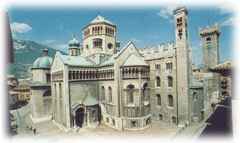Duomo
 The
cathedral is a severe, romanic-gothic building of the twelfth-thirteenth century with a
striking fifteenth-century tower and neoromanic lantern. Dedicated to Saint Vigilio
(patron saint of Trento), it has graceful open galleries decorated by large rosettes on
the front and transept, by sumptuous portals and a beautiful absidal section. This last
borders with the "Castelletto", a twelfth-century building with mullioned
windows and battlements. The interior is made up of a nave and two aisles with clustered
pillars and cross-vaults. Staircases cut laterally across the walls at the beginning of
both aisles. Funerary monuments of the fifteenth century are located along their whole
length. Half way up the right-hand aisle, there is St. Anne's altar with decorations by
Fogliolino. This is shortly followed by "la cappella del Crocifisso" (Crucifix
chapel), which guards the historical wooden Crucifix (XVI century) of the German sculptor
Sisto Frey, in front of which the Concilium formulated its decrees. The transept presents
noteworthy remains of thirteenth- and fifteenth-century frescoes. A stone statue of
"La Madonna degli Annegati" (Drowned peoples' Madonna) is situated at the bottom
of the left hand aisle (XIII century). Its name goes back to the times when drowned people
were identified in its presence. The statue used to be in an alcove outside the cathedral.
A room below the church contains the remains of the paleochristian basilica of the sixth
century, used as catacombs for five centuries. Rebuilt and modified in the eleventh
century, it was replaced by the present cathedral by archbishop Federico Vanga in the
thirteenth century. It was excavated in 1977, and contains pieces of the outer walls,
remains of the mosaic flooring and fragments of sculptures.
The
cathedral is a severe, romanic-gothic building of the twelfth-thirteenth century with a
striking fifteenth-century tower and neoromanic lantern. Dedicated to Saint Vigilio
(patron saint of Trento), it has graceful open galleries decorated by large rosettes on
the front and transept, by sumptuous portals and a beautiful absidal section. This last
borders with the "Castelletto", a twelfth-century building with mullioned
windows and battlements. The interior is made up of a nave and two aisles with clustered
pillars and cross-vaults. Staircases cut laterally across the walls at the beginning of
both aisles. Funerary monuments of the fifteenth century are located along their whole
length. Half way up the right-hand aisle, there is St. Anne's altar with decorations by
Fogliolino. This is shortly followed by "la cappella del Crocifisso" (Crucifix
chapel), which guards the historical wooden Crucifix (XVI century) of the German sculptor
Sisto Frey, in front of which the Concilium formulated its decrees. The transept presents
noteworthy remains of thirteenth- and fifteenth-century frescoes. A stone statue of
"La Madonna degli Annegati" (Drowned peoples' Madonna) is situated at the bottom
of the left hand aisle (XIII century). Its name goes back to the times when drowned people
were identified in its presence. The statue used to be in an alcove outside the cathedral.
A room below the church contains the remains of the paleochristian basilica of the sixth
century, used as catacombs for five centuries. Rebuilt and modified in the eleventh
century, it was replaced by the present cathedral by archbishop Federico Vanga in the
thirteenth century. It was excavated in 1977, and contains pieces of the outer walls,
remains of the mosaic flooring and fragments of sculptures.